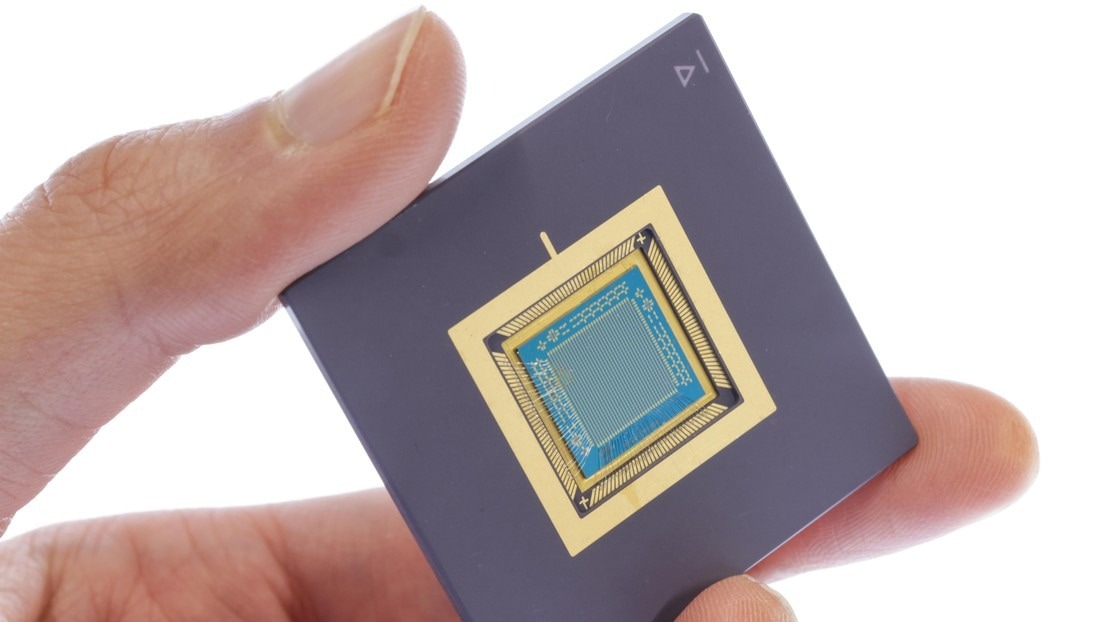EPFL researchers have developed the first large-scale in-memory processor using 2D semiconductor materials, which might significantly reduce the energy footprint of the ICT sector.

Image Credit: 2023 EPFL
When information and communication technology (ICT) processes data, electricity is converted into heat. The global ICT ecosystem already has a CO2 footprint comparable to that of aviation. However, it turns out that a large portion of the energy required by computer processors does not go toward doing calculations. Instead, the majority of the energy necessary to process data is spent moving bytes from memory to processor.
Researchers from the EPFL School of Engineering’s Laboratory of Nanoscale Electronics and Structures (LANES) have developed a new processor that addresses this inefficiency by combining data processing and storage onto a single device—a so-called in-memory processor—and have published their findings in the journal Nature Electronics.
In an important step toward industrial manufacturing, they created the first in-memory processor based on a two-dimensional semiconductor material with over 1000 transistors, setting a new precedent.
Von Neuman’s Legacy
As per Andras Kis, the study’s lead, the widely used von Neumann design is the primary cause of today’s processor’s inefficiency. Specifically, the actual physical division of the parts that are utilized for data storage and computation.
Due to this separation, for processors to carry out calculations, they must obtain data from memory. These operations entail the movement of electrical charges, the charging and discharging of capacitors, and the transmission of currents along lines, all of which use energy.
This architecture made sense up until around 20 years ago since distinct kinds of devices were needed for data processing and storage. But more effective substitutes are posing a growing threat to the von Neumann design.
Today, there are ongoing efforts to merge storage and processing into a more universal in-memory processors that contain elements which work both as a memory and as a transistor.
Andras Kis, Study Lead and Full Professor, Laboratory of Nanoscale Electronics and Structures, Swiss Federal Institute of Technology in Lausanne
His lab has been investigating ways to use the semiconductor material molybdenum disulfide (MoS2) to accomplish this purpose.
A New Two-Dimensional Processor Architecture
Guilherme Migliato Marega, a doctoral assistant at LANES, and his co-authors propose a MoS2-based in-memory processor in their research published in Nature Electronics that is specifically designed to perform vector-matrix multiplication, one of the fundamental operations in data processing.
Artificial intelligence models and digital signal processing both use this method extensively. Enhancements in its effectiveness could result in significant energy savings for the ICT industry as a whole.
Their processor packs 1024 components into a chip that is one centimeter by one centimeter. Each element consists of a floating gate and a 2D MoS2 transistor. The floating gate stores a charge in its memory to regulate the conductivity of each transistor. This type of coupling between memory and processing radically alters how the processor performs the calculation.
Kis added, “By setting the conductivity of each transistor, we can perform analog vector-matrix multiplication in a single step by applying voltages to our processor and measuring the output.”
A Big Step Closer to Practical Applications
The material they chose, MoS2, was critical in constructing their in-memory processor. For starters, MoS2 is a semiconductor, which is required for the construction of transistors. In contrast to silicon, the most commonly utilized semiconductor in today’s computer processors, MoS2 creates a stable monolayer barely three atoms thick that interacts with its environment relatively weakly.
Because of its thinness, it has the ability to manufacture exceedingly tiny gadgets. Finally, it is a material that Kis’s lab is well-versed in. They built their first single MoS2 transistor in 2010 using a monolayer of the material scraped off a crystal with Scotch tape.
Their procedures have grown significantly over the last 13 years, with Migliato Marega’s efforts playing a vital role.
Kis added, “The key advance in going from a single transistor to over 1000 was the quality of the material that we can deposit. After a lot of process optimization, we can now produce entire wafers covered with a homogenous layer of uniform MoS2. This lets us adopt industry standard tools to design integrated circuits on a computer and translate these designs into physical circuits, opening the door to mass production.”
Revitalizing European Chip Manufacturing
Kis views this result as evidence of the significance of close scientific collaboration between Switzerland and the EU, especially in light of the European Chips Act, which aims to support Europe’s resilience and competitiveness in semiconductor technologies and applications, aside from its purely scientific value.
“EU funding was crucial for both this project and those that preceded it, including the one that financed the work on the first MoS2 transistor, showing just how important it is for Switzerland,” Kis further added.
He concluded, “At the same time, it shows how work carried out in Switzerland can benefit the EU as it seeks to reinvigorate electronics fabrication. Rather than running the same race as everyone else, the EU could, for example, focus on developing non-von Neumann processing architectures for AI accelerators and other emerging applications. By defining its own race, the continent could get a head start to secure a strong position in the future.”
Journal Reference:
Marega, G. M., et al. (2023) A large-scale integrated vector–matrix multiplication processor based on monolayer molybdenum disulfide memories. Nature Electronics. doi:10.1038/s41928-023-01064-1